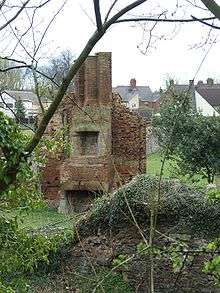Hartshill Castle
Hartshill Castle is a ruined castle in the village of Hartshill on the outskirts of Nuneaton, Warwickshire (grid reference SP325942). It is on Historic England's Heritage at Risk Register due to erosion, structural problems and vandalism.[1]

It was built as a motte and bailey castle in the 12th century by Hugh de Hardreshull in 1125. Robert de Hartshill was killed alongside Simon de Montfort in the Battle of Evesham in 1265 and the castle fell into disuse. In 1330, it was rebuilt by John de Hardreshull.
In Tudor times a timber-framed manor house was built into the corner. Now all that remains of the house is a chimney. The earthworks of the castle and remains of the house are still present. The site is privately owned. In Tudor times after the Battle of Bosworth, King Henry VII is believed to have stayed at the property.
No other place in Warwickshire has such evidence of continuous habitation since earliest times as this Hartshill/Oldbury Ridge.
Stone Age tribes lived here in 10,000 B.C. They were nomads, not travelling far, but wandering, always returning to this area for flints which they needed for tools and weapons. They found them in the boulder clay at the foot of Hartshill Ridge, near the River Anker. Remains of Stone Age flints and bones of Red Deer and Woolly rhinoceroses have been found in sand and gravel near to the river at Witherly.
So over centuries Stone Age and Bronze Age people, Romans, Saxons, Danes and Normans all stamped a way of life on this area.
In the Domesday Survey of 1086 Hartshill is known as Ardreshill. Thirteen families lived here at a time when tracks through the forest were deep and difficult to find.
Hugh De Hardreshill was given the manor in 1125. It was he who built the first defensive system: a motte and bailey (a mound and enclosed yard) here on this castle site, overlooking Atherstone. The walls were made of wood and on top of the motte was a wooden tower which was home to the Lord of the Manor and his family, as well as being a look-out post.
The first stone building at the castle was the chapel, built in the 13th century. Little of this remains above the ground. A hundred years later the wooden palisades of the bailey were replaced by stone walls 4 feet thick and 15 feet high, pierced with cross-loops in sandstone.
A section of water-filled moat remains on the west side. The north door survives and there are traces of the west door, but no indication above ground of the main entrance which would have been on the south side. It is likely that there would have been a tower in the south-west corner.
A later Tudor house was built into the north-east corner about 1560, but of this only the south-east chimney stack remains. The rest of the house, with its timber frame and wattle and daub walls, was demolished in the 1950s.
References
- Heritage at Risk Register 2018, West Midlands (Report). Historic England. p. 39. Retrieved 29 December 2018.
- Fry, Plantagenet Somerset, The David & Charles Book of Castles, David & Charles, 1980. ISBN 0-7153-7976-3
External links
- Heritage at Risk Register: Hartshill+Castle